Comprehensive Guide to Brush Mowing Equipment
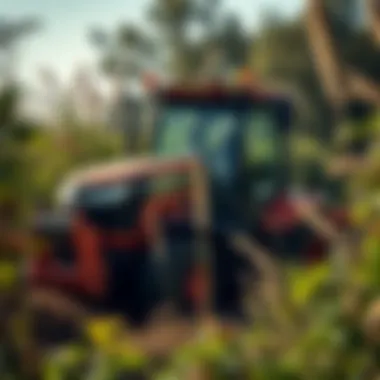
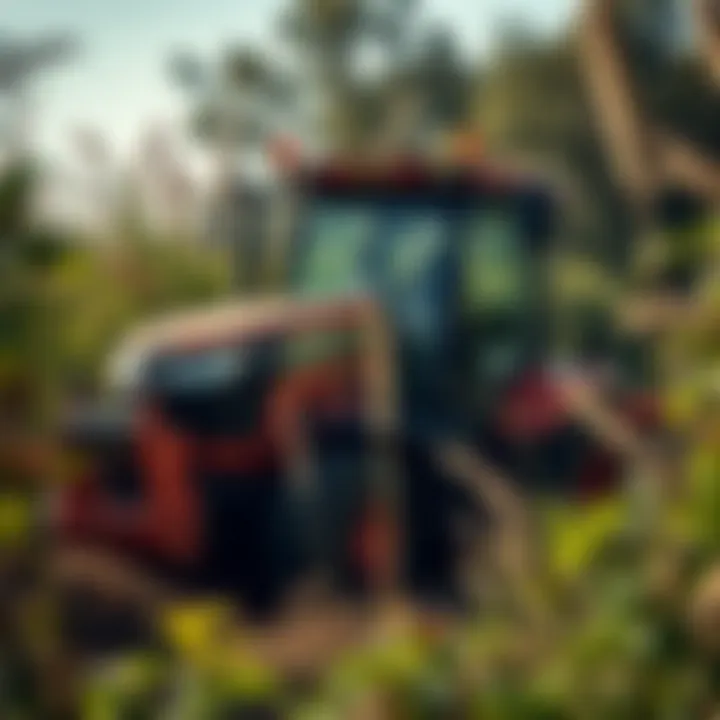
Intro
Brush mowing equipment plays a pivotal role in managing landscapes, whether they be in agricultural fields, private gardens, or public parks. As effective tools for controlling dense vegetation, these machines help create safe and accessible areas, facilitating various land management practices. Understanding how these machines work, the different types available, and their specific applications is essential for both professionals and enthusiasts. This article aims to unravel the intricacies of brush mowing equipment, covering everything from their operational mechanisms to tips on maintenance and selection, ensuring you are well-equipped for your land management needs.
Key Insights
Overview of the Topic
Brush mowing is not just about trimming tall grass; it's about tackling tough brush and overgrown areas that traditional mowers might not handle well. These machines are designed to handle a variety of vegetation, including small trees, shrubs, and thick weeds. The variety of models is extensive, ranging from walk-behind mowers to powerful tractor-mounted options. Each type serves distinct functions depending on the scale and nature of the task at hand.
Importance in Agriculture/Horticulture/Agronomy
In agriculture and horticulture, brush mowing equipment is vital for maintaining crop health and ensuring efficient land use. For farmers, regular brush mowing can prevent the spread of invasive species, reduce fire hazards, and create more fruitful growing conditions. Similarly, in horticulture, these tools contribute significantly to landscape maintenance, allowing gardeners to manage their green spaces effectively. The encouragement of biodiversity through proper land management using these machines can have lasting benefits, fostering ecosystems that support both flora and fauna.
"Using brush mowers can significantly enhance land productivity, turning overgrown fields into thriving agricultural plots."
Sustainable Practices
Eco-Friendly Techniques
In today's world, where sustainability is at the forefront, the use of brush mowing equipment aligns well with eco-friendly practices. Electric and battery-powered brush mowers, for example, are gaining popularity due to their reduced carbon footprint compared to traditional gas-powered machines. Moreover, techniques like mulching during mowing not only manage vegetation but also enrich the soil, supporting a greener approach.
Case Studies on Sustainability
Several case studies highlight how effective brush mowing practices have led to enhanced ecological balance. In specific regions of Oregon, farmers implementing brush mowers reported improvements in soil quality and biodiversity through controlled mowing techniques. The integration of these mowers alongside conservation practices shows a promising path forward in sustainable agriculture, tapping into natural processes while fostering productivity.
Tools & Resources
Essential Equipment and Technologies
When investing in brush mowing equipment, it’s crucial to consider your specific needs. Here’s a short list of essential types of brush mowers:
- Walk-behind brush mowers: Ideal for small properties or tight spaces, easy to operate.
- Riding brush mowers: Suitable for larger areas, providing comfort and efficiency.
- Tractor-mounted mowers: For expansive farms, these powerful machines can cover vast land quickly.
Recommended Books and Readings
For those looking to deepen their knowledge of brush mowing and land management, a few valuable resources include:
- The Brush Mowing Handbook by John Smith. This book covers operational techniques and best practices.
- Sustainable Landscapes: A Practical Guide available on en.wikipedia.org.
- Various online forums such as Reddit's r/farming, where enthusiasts share experiences and tips on brush mowing and equipment selection.
Prologue to Brush Mowing Equipment
In the realm of modern agriculture and land management, brush mowing equipment stands as a pivotal solution for managing undergrowth and vegetation. These machines have become indispensable for anyone looking to maintain land effectively, whether for aesthetic appeal or functional use. They help tackle overgrown areas, making way for crops, enhancing landscape beauty, and ensuring safety in residential areas. Understanding brush mowing isn't merely about the machines; it encompasses recognizing their applications, benefits, and how best to select the appropriate model for specific needs.
Defining Brush Mowing Equipment
Brush mowing equipment is often misunderstood by those unfamiliar with land management practices. At its core, it refers to tools designed for cutting down thick vegetation, including bushes, brambles, and tall grasses. This equipment comes in various forms, from walk-behind mowers to tractor-mounted options, each serving its own unique purpose depending on the scale and type of land being managed. Walk-behind models are ideal for smaller plots, while larger machines, such as those attached to tractors, are built for tackling extensive agricultural fields or rugged landscapes.
The variety in design and function also includes specialized options like clearing saws, which provide versatility in brush management. These machines don’t just cut; they play a vital role in land maintenance, promoting healthier ecosystems by clearing invasive species and allowing native flora to thrive.
Historical Context and Evolution
Brush mowing's roots stretch back decades, as land management faced challenges from the encroachment of nature on cultivated grounds. Originally, landowners relied on manual labor with handheld tools, which, as you can imagine, was laborious and time-consuming. This led to the quest for mechanization, yielding equipment that greatly increased efficiency and reduced labor costs.
Over time, as society evolved and the farming sector expanded, so did the technology behind brush mowers. Early mechanized mowers were basic and often prone to mechanical failures. However, ongoing advancements in engineering and materials have evolved these tools into sophisticated machines equipped with powerful cutting blades and engines designed to tackle tough terrains. Today, for instance, manufacturers integrate ergonomic designs and safety features, making them more user-friendly and safer for operators.
The evolution of brush mowing equipment mirrors advances in agricultural practices and changing environmental concerns. Where once the goal was solely productivity, today’s machines also consider sustainability. The design focus has shifted to minimize environmental impact, leading innovators to create more efficient and eco-friendly models.
In summary, understanding brush mowing equipment is fundamental not just for practical functionality, but also for recognizing its role in the overall landscape of agriculture and horticulture today. With continued evolution, these tools will undoubtedly adapt further, shaping the future of land management.
Types of Brush Mowing Equipment
Understanding the different types of brush mowing equipment is crucial for any land management effort, whether agricultural or horticultural. Each type serves a specific purpose, and knowing their strengths allows users to optimize for efficiency and effectiveness. This section will explore the array of brush mowers available today, examining key characteristics, operational uses, and the unique benefits that each type can provide.
Walk-Behind Brush Mowers
Walk-behind brush mowers represent an agile solution for mowing tasks that may have restrictive access or smaller areas that require careful maneuvering. These mowers are typically lightweight and easy to operate, making them ideal for residential homeowners or small-scale farmers who maintain less expansive plots. The cutting width generally ranges from 20 to 32 inches, allowing operators to navigate around trees, flower beds, and other features with ease.
"For folks who want control and precision, the walk-behind option can’t be beaten."
Additionally, walk-behind mowers often have adjustable cutting heights, making them versatile for various brush thicknesses. With convenient features like self-propelled capabilities, users can confidently tackle tougher conditions without too much strain.
Riding Brush Mowers
Riding brush mowers, on the other hand, usher in a different game entirely. These robust machines allow operators to cover larger landscapes without the physical toll associated with walk-behind versions. Riders typically feature wider cutting decks, making quick work of thick undergrowth across vast expanses of land.
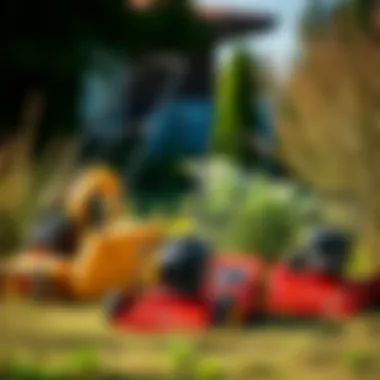

The advantage of riding mowers extends beyond sheer size; they often include enhancements such as multiple speed settings, various attachments for different jobs, and better fuel efficiency. This flexibility makes them well-suited for farms and large gardens where productivity truly matters.
Users may find brands like Cub Cadet or John Deere among the frontrunners in this category, renowned for durability and performance. They provide options with enhanced comfort features so that operators can work longer without fatigue.
Brush Mowers for Tractors
If you’re looking to tackle heavy-duty jobs, brush mowers designed specifically for tractors are worth considering. These units are typically more powerful and are attached to a tractor’s three-point hitch, allowing the mower to leverage the tractor’s weight and hydraulic system. This type is particularly effective in clearing dense brush, tall grass, and even small trees, revolutionizing the ability to manage larger parcels of land efficiently.
Furthermore, many tractor brush mowers have features like heavy-duty blades and reinforced frames that ensure durability when tackling the toughest environments.
Clearing Saw Options
Last but certainly not least are clearing saws, which should not be overlooked in brush mowing discussions. These portable, handheld machines are a hybrid between chain saws and brush cutters. They can slice through thick brush and small trees with ease. Often used in tight spaces, they provide the precision needed for landscaping tasks or in forestry applications to maintain trails or clear firebreaks.
The versatility of clearing saws makes them valuable tools not only in agriculture but also in construction and ecological management. Users looking for lightweight and portable options will appreciate their maneuverability when working in challenging terrains.
In summary, understanding the landscape, size of area, and specific mowing needs will go a long way in determining the most suitable brush mowing equipment. Each type, from walk-behinds to tractor-mounted mowers and clearing saws, has its merits. It's all about finding that perfect fit for your unique requirements.
Key Components of Brush Mowers
Understanding the key components of brush mowers is essential not just for those engaged in agriculture, but also for landscaping and land management enthusiasts. Each element of a brush mower plays a vital role in determining its overall performance, durability, and effectiveness in various applications. When selecting a brush mower, knowing how these components function and their importance can make a significant difference in achieving optimal outcomes in your land-clearing efforts.
Cutting Mechanisms
The cutting mechanism is arguably the most critical component of any brush mower. This dictates how effectively the machine can slice through tough vegetation. Common types of cutting mechanisms include rotary blades, flail mowers, and brush cutters.
Rotary Blades: These are widely recognized and are typically used for most applications. They work by spinning horizontally, chopping through brush and grass efficiently. The metal blades are sharp and can handle much thicker materials if properly maintained. For dense undergrowth, these blades perform at their best and buck the conventional limitations of traditional mowing methods.
Flail Mowers: Another popular choice among farm operators, flail mowers utilize a series of small blades on a rotating shaft. Each blade can pivot independently, allowing for a more flexible approach to uneven terrain. This results in a cleaner cut and reduces the risk of hitting rocks or hard surfaces. They are particularly valuable in maintaining estates or agricultural lands where aesthetics are equally important as functionality.
Brush Cutters: These mechanisms resemble handheld trimmers but are mounted on heavier machinery. They feature serrated metal blades designed to cut thick brush and even small trees. Operators benefit from their versatility and power, enabling them to tackle a wide range of vegetation.
"Choosing the correct cutting mechanism depends on the type of vegetation and the specific tasks at hand. A poorly selected blade can hinder efficiency and lead to increased mechanical issues."
Power Sources
The power source of brush mowers determines not just their performance, but also their usability and maintenance needs. There are typically three major power sources used.
Gas Engines: Gas-powered options provide robust performance for larger and more demanding jobs. They usually deliver more torque and power compared to electric models, making them suitable for heavy brush clearing. However, they require regular maintenance and the cost of fuel can add up, especially for extensive land-clearing projects.
Electric Motors: Battery-powered mowers have been gaining traction thanks to advancements in battery technology. They are quiet, emit no fumes, and generally require less maintenance, making them an appealing option for homeowners and small property managers. While their power might not match that of gas engines for extensive cutting needs, they shine in residential areas where noise reduction is essential.
Hybrid Systems: Some newer models combine both electric and gas power. These hybrids can provide the best of both worlds—offering quiet operation and less environmental impact while still delivering the power needed for tougher tasks. However, they may come at a premium price and can require specialized knowledge for efficient operation and maintenance.
Frames and Wheels
The frame and wheels are often overlooked but are highly important when considering the durability and maneuverability of a brush mower.
Frame Construction: A sturdy frame provides the necessary durability for heavy-duty applications. Most frames are made from steel or composite materials. Steel frames tend to offer greater strength at the expense of increased weight, which can make maneuverability a challenge on uneven terrain. Conversely, lighter frames can be easier to maneuver but may not withstand the rigors of heavy brush cutting.
Wheel Design: The wheels must be designed for the intended terrain. Larger, wider wheels are ideal for rolling over rough ground without getting stuck. Some models even come with all-terrain capabilities, allowing the mower to traverse through mud, gravel, or hilly environments.
- High-traction tires can significantly enhance control and stability during operation.
- A gear-reduction system in the wheels can improve cutting performance in dense vegetation.
In summary, understanding the key components—the cutting mechanisms, power sources, and the frame and wheels—of brush mowers offers immense insight into selecting the right equipment for specific applications. Each component interacts with one another to ensure that the mower operates effectively, safely, and efficiently across different landscapes.
Applications of Brush Mowing Equipment
Brush mowing equipment is not just a tool; it is an essential asset in various fields, particularly agriculture and horticulture. The applications of these machines extend well beyond simple cutting. By targeting the specific needs of land management, agricultural preparation, and landscape maintenance, brush mowers contribute significantly to efficiency and productivity. Understanding these applications can help users make informed choices when selecting equipment, ultimately enhancing their practices.
Land Management Practices
Managing land effectively means maintaining healthy habitats and ecosystems. Brush mowers play a critical role in this area. They assist in controlling invasive plant species, reducing the risk of wildfires, and promoting biodiversity by facilitating the growth of native plants. Moreover, routine brush mowing can help maintain open areas for wildlife, ensuring their habitats are preserved. This practice not only contributes to environmental health but also helps in increasing the aesthetic appeal of the land.
When leveraging brush mowers for land management, it is vital to consider factors such as:
- Frequency of Mowing: Regular usage keeps invasive species at bay.
- Mower Type: Different mowers suit different terrains and vegetation types.
- Timing: Seasonal changes affect plant growth; coordinating mowing during specific periods can enhance ecological outcomes.
"Effective land management requires more than mere maintenance—it is about fostering a balanced ecosystem that supports diverse life forms."
Preparing Agricultural Lands
In agriculture, preparing lands for crops is a sophisticated affair, demanding the right tools and techniques. Brush mowers streamline this process by clearing areas of heavy brush and overgrowth, allowing for better soil preparation. They can be the difference between a well-prepared field and one choked with weeds and debris.
Farmers can utilize brush mowing in preparation by considering:
- Soil Quality: Clearing brush allows for soil tests and amendments to be effectively applied.
- Equipment Type: Selecting the right mower impacts the soil structure; heavier machinery can compact soil.
- Integration with Other Practices: Combining brush mowing with tillage or planting systems promotes efficiency.
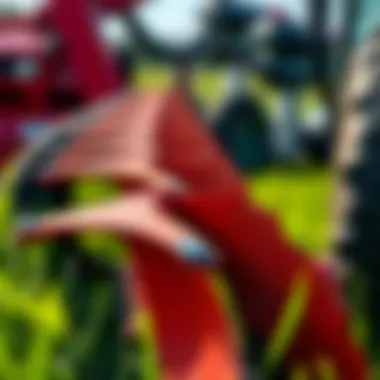
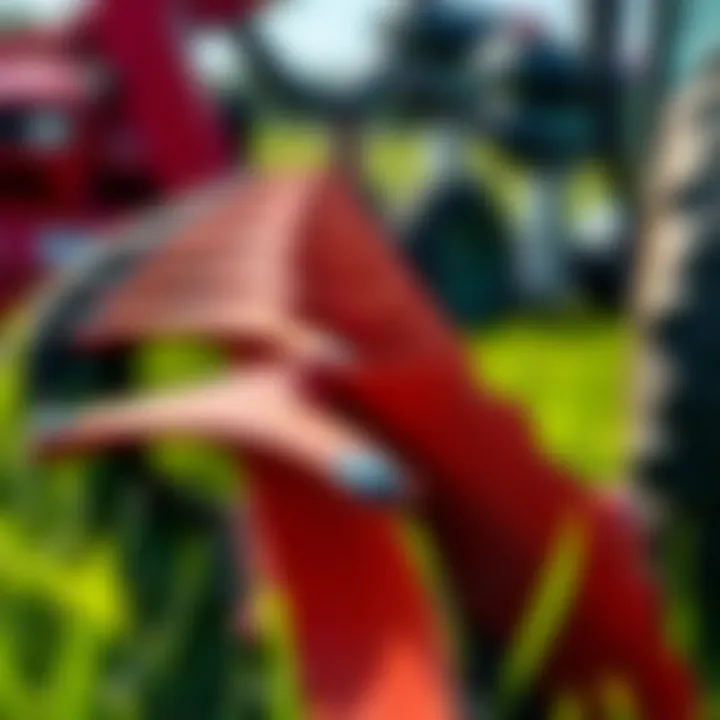
This preparation not only facilitates sowing but also aids in maximizing yields, making it a practical investment for any serious farmer.
Maintaining Aesthetic Landscapes
Aesthetic landscapes require continuous care to remain appealing and vibrant. Brush mowers come into play, ensuring that ornamental gardens, parks, and residential areas are well-maintained. Their versatility allows homeowners and landscape managers to tackle overgrown areas quickly, ensuring that the beauty of the space is not lost.
Some key considerations for maintaining aesthetic landscapes include:
- Mowing Height: Maintaining the right cutting height is crucial for the health of grass and plants.
- Frequency: Regular cutting leads to lush, green growth without the risk of unsightly overgrowth.
- Blade Maintenance: Sharp blades result in cleaner cuts, which promotes plant health and aesthetics.
By prioritizing these elements, users can keep their landscapes looking their best, enhancing property value and personal enjoyment.
Benefits of Using Brush Mowers
Brush mowers aren’t just a convenience; they bring significant benefits to users, especially in agricultural settings. They transform lawn care or land management from a labor-intensive chore into a more streamlined and efficient process. Understanding these advantages provides insight into why investing in brush mowers can be a smart choice for both farmers and gardening enthusiasts alike.
Increased Efficiency
The primary allure of brush mowers lies in their efficiency. When it comes down to clearing out thick brush, high grass, and undergrowth, these machines pack a punch. It’s like having a trusty steed that gallops through the toughest of terrains. They can handle tough jobs that inexpensive trimmers simply can’t tackle without a serious time commitment. For large plots of land, where every minute counts, these mowers can significantly reduce the amount of time spent on upkeep.
With robust cutting mechanisms, brush mowers swiftly eliminate dense vegetation. Whether it's overgrown fields or untamed backyards, owners can often finish a day's work in a fraction of the time compared to manual methods. Furthermore, features like adjustable cutting heights empower users to customize mowing based on the specific conditions of their land. This adaptability contributes to a more thorough finish, allowing the land to be prepared or maintained optimally with less rework.
Cost-Effectiveness
Investing in brush mowers can yield long-term financial savings. The initial purchase might seem hefty, but think of it as buying a high-quality tool that pays for itself over the years. By cutting down on labor costs and time, users can allocate more resources toward other critical areas of their operations.
Moreover, the maintenance costs tend to be lower compared to more specialized clearing equipment. Regular upkeep is essential, of course, yet the ease of maintenance for many brush mowers keeps costs manageable. Additionally, fuel efficiency in certain models has improved over the years, meaning users won’t break the bank filling up their tanks.
"The money saved on hiring outside help can instead be reinvested into improving or expanding operations, making brush mowers a smart long-term investment."
Environmental Considerations
In a world increasingly aware of sustainability, brush mowers can play a role that’s beneficial to both users and their environment. These machines help in land management practices that promote healthier ecosystems. When used correctly, brush mowers can reduce the need for harsh herbicides, which often do more harm than good. Instead, they allow for natural ground cover and native plants to flourish by controlling invasive species.
Employing brush mowers in routine land management can also minimize soil erosion, maintaining the integrity of the land while improving its overall health. By reducing the layers of decaying plant material, thatch can be managed more effectively, allowing for better water absorption and nutrient penetration.
In summary, the benefits of using brush mowers encompass enhanced efficiency, cost savings, and a positive environmental impact. Each factor contributes to why these machines have become indispensable for those dedicated to agriculture and landscaping. Understanding these aspects can significantly influence purchasing decisions, ensuring the right tool for the job.
Selecting the Right Brush Mowing Equipment
Choosing the right brush mowing equipment is not just a matter of brand preference or looks. This decision can have significant implications on the efficiency of land management and the quality of results achieved. Selecting the appropriate type of mower hinges on various pivotal factors like land conditions, the specific needs of the operator, and financial constraints. Each element plays a critical role in ensuring that the equipment serves its purpose effectively and efficiently.
Assessing Land Conditions
When it comes to brush mowing, understanding the nature of the land is crucial. Different terrains pose unique challenges, and thus interpreting these conditions can determine the type of mower that will best suit the task at hand. For instance, consider the difference between a hilly area versus a flat expanse.
- Terrain Type: If the land is uneven or has many slopes, a riding mower with suitable traction features may be necessary. Conversely, for flat, expansive areas, a walk-behind mower might do the trick just fine.
- Vegetation Density: The size and density of the vegetation also play a role. Heavy brush with thick, woody stems will likely require more robust machinery capable of handling tougher tasks, such as tractor-mounted mowers.
- Soil Conditions: Poorly drained or muddy soil may not support traditional mowers well. Operators may need to seek models specifically designed for such conditions which can navigate without getting stuck.
Understanding these aspects helps narrow down the choices and aids in making the selection that’s both practical and effective for your specific landscape needs.
Understanding Operator Needs
The operator's experience and comfort level with various types of equipment is also paramount. A mower that is easy to handle for one person might not be suitable for another. Here’s what to consider:
- Skill Level: If the operator is a seasoned hand with extensive experience, they might prefer the versatility of more advanced technology. However, for someone new to brush mowing, simpler models that require less technical know-how might be a better fit.
- Physical Capability: The physical condition of the operator should be taken into account; walk-behind mowers may be more suitable for those who prefer exerting less effort or have mobility limitations.
- Work Purpose: Understanding the specific goals for mowing—be it maintaining a pathway, clearing underbrush, or thinning out dense brush—can directly influence equipment selection.
Customizing equipment choices based on these operator-specific needs can significantly enhance not only productivity but also the overall mowing experience.
Budget Considerations
The financial aspect of selecting brush mowing equipment cannot be overlooked. Here are essential points to consider:
- Initial Cost: Higher price tags often come with more advanced features, so it is important to assess what is necessary versus what is simply desirable. Consider entry-level models if finances are tight, as they can still tackle less demanding tasks.
- Maintenance Costs: Beyond the purchase price, consider the ongoing maintenance costs associated with more complex machines. Some models may require more frequent servicing than others, which can add up over time.
- Long-Term Value: Investing in a higher-quality mower may initially strain the budget but often pays off in durability and efficiency. In contrast, opting for a cheaper alternative might lead to greater expenses down the line due to repairs or replacements.
Finding the right balance between cost and quality is essential for a wise investment that will serve its purpose efficiently without breaking the bank.
"Selecting the right brush mower is akin to choosing the right tool for the job; the right fit can lead to reduced effort and better results."
In essence, each of these considerations requires careful thought. By taking a systematic approach—assessing land conditions, understanding operator needs, and weighing budget constraints—a more informed decision regarding brush mowing equipment can be made. This foundation will set the stage for achieving better outcomes in clearing, maintaining, and managing land.
Maintenance of Brush Mowers
Maintaining brush mowers is crucial for optimal performance and longevity. Proper upkeep not only enhances efficiency but also minimizes repair costs in the long run. When you invest in brush mowing equipment, keeping it in good working order is as essential as choosing the right model. Regular maintenance ensures that the mower operates smoothly and safely, ultimately supporting better land management practices. Moreover, understanding the components and functions of your brush mower can lead to more aware and responsible usage, allowing operators to recognize any signs of wear or malfunction early on.
Routine Checks and Upkeep


Routine checks serve as the backbone of brush mower maintenance. These checks should not be skipped, as they generally catch issues before they escalate into serious problems. Operators can follow a straightforward checklist:
- Inspect the blades: Regularly examine the cutting edges for dullness or damage. Sharpening or replacing blades keeps the mower efficient and ensures a clean cut.
- Check oil levels: Keeping an eye on oil levels helps to lubricate the engine and prevents overheating. Routine oil changes can extend the life of the mower.
- Examine belts and cables: Look for any signs of wear on belts and cables as they can cause operational issues when worn out.
- Tire pressure: Proper tire inflation aids in handling uneven terrain and maximizes fuel efficiency.
Scheduling these checks quarterly at a minimum or after heavy use can proactively maintain mower functionality.
Repair Procedures
Even with routine maintenance, repairs might still be necessary. Knowing how to go about fixing common issues can save both time and money. Here are steps for repair procedures that are often needed:
- Identify the problem: If the mower isn't performing well, investigate. Look for signs like strange noises or lack of power.
- Refer to the manual: Every model comes with a specific user manual that outlines common issues and troubleshooting methods. Ensure to keep this handy.
- Changing components: If blades need sharpening or belts are frayed, these components can often be replaced at home with basic tools. Just make sure to use parts specifically designed for your machine.
- Engage a professional: When in doubt and if the problem seems beyond your skill set, don’t hesitate to contact a qualified technician to assess and proceed with repairs.
Comprehensive knowledge about potential issues can make the repair process smoother.
Storage and Seasonal Care
Proper storage of brush mowing equipment is just as important as its maintenance during active use. By preparing for off-seasons or winter months, users can significantly extend the lifespan of their equipment. Here are some tips for optimal seasonal care:
- Clean thoroughly: Before storage, ensure the mower is cleaned of all clippings, dirt, and debris. A clean surface discourages rust and can help preserve the paint.
- Consider draining fuel: If the mower won't be used for a long time, draining the fuel can prevent gumming of the fuel system.
- Store indoors: If possible, keep the mower inside a shed or garage, protecting it from harsh weather conditions.
- Cover if stored outside: If indoor storage isn't an option, cover the mower with a durable tarp to safeguard it against the elements and UV damage.
"A little planning during off-season can save a whole lot of hassle come spring."
All in all, investing the time into maintenance, repairs, and proper storage can make a world of difference in the performance and durability of brush mowers. By developing a routine and adhering to best practices, operators ensure their equipment serves them well for many seasons to come.
Safety with Brush Mowing Equipment
Brush mowers can be real game changers in agriculture and horticulture, but they aren't without risks. Just like a double-edged sword, they can help with land management while simultaneously presenting dangers. Proper safety measures are critical for protecting operators and surrounding individuals. Recognizing and implementing these safety protocols is crucial for ensuring a productive and responsible mowing experience.
Personal Protective Equipment
When operating brush mowing machinery, the right personal protective equipment (PPE) isn’t just a precaution, it’s a necessity. Think of it as your first line of defense against potential hazards. Here are some essential pieces to consider:
- Helmet: A good-quality helmet shields your head from falling debris, which can cause serious injuries.
- Safety Glasses: Protecting your eyes is paramount. Safety glasses or goggles can prevent eye injuries from flying particles.
- Ear Protection: Brush mowers can be unbearably noisy, risking permanent hearing damage. Earplugs or earmuffs can help maintain your hearing health.
- Gloves: A sturdy pair of gloves protects your hands from cuts and abrasions.
- Steel-Toe Boots: Wearing boots with steel toes can guard against injuries, particularly from heavy equipment or logs that might fall.
Investing in these items is just smart. They can potentially save you from debilitating injuries. Always remember, it is far easier to wear protective gear than to endure recovery from an injury.
Operational Safety Guidelines
Grasping the operational safety guidelines is imperative beyond just wearing the right gear. Here are some key pointers:
- Read the Manual: Before starting any equipment, familiarize yourself with the operator's manual. It contains specific safety protocols tailored for your brush mower model.
- Inspect Equipment: Always ensure that your mower is in good working condition. Regular maintenance checks can prevent equipment malfunction during use.
- Clear the Area: Before mowing, clear the area of rocks, branches, or any debris that could become projectiles.
- Be Aware of Your Surroundings: Keep an eye out for people and animals nearby. If children are playing or there are pets around, relocate them away from the mowing zone.
- Maintain Proper Distance: Keep bystanders at least 50 feet away from your mowing path. This distance helps prevent accidents.
- Use Caution on Slopes: Whether mowing on flat ground or tackling hilly terrain, always prioritize stability. When mowing slopes, keep your body facing downhill and avoid cutting too close to the edge.
Much like the wise adage goes, "An ounce of prevention is worth a pound of cure". Adhering to these guidelines isn’t just about following rules; it’s about ensuring a safe work environment and enjoying the benefits of brush mowing without complications.
Future Trends in Brush Mowing Technology
The field of brush mowing technology is undergoing transformative changes, and understanding these trends is vital for anyone involved in land management or agriculture. As the landscapes we manage evolve, so do the needs and expectations from equipment designed to maintain them efficiently and sustainably. The emerging technologies offer a glimpse into the future of brush mowing, emphasizing enhancements in efficiency, productivity, and environmental stewardship.
Advancements in Efficiency
When it comes to brush mowers, efficiency is king. Recent advancements in technology have revolutionized how these machines operate, resulting in significantly improved performance. Companies are now leveraging artificial intelligence and machine learning to develop smarter mowers that can adapt to various terrains and vegetation types. This capability is particularly useful for operators who face diverse landscaping challenges across different properties.
For example, think about mowers outfitted with sensors that can detect the density of brush. These machines can adjust their cutting speed automatically based on the thickness of the vegetation they are tackling. This not only saves time but also extends the life of the equipment as it isn't overworking itself unnecessarily.
Another noteworthy innovation is battery-powered brush mowers. These are becoming increasingly commonplace, offering the advantage of lower noise levels and reduced emissions compared to traditional gas-powered models. This shift serves not only operational needs but also addresses growing environmental concerns among both operators and the communities in which they operate.
"Advances in brush mowing technology mirror broader enhancements in agricultural tools, making tasks faster and healthier for our planet."
Sustainable Practices and Innovations
The future of brush mowing isn't just about improving the machines; it’s also about fostering sustainable practices that benefit the environment. Manufacturers are responding to a rising demand from consumers for eco-friendly products, and this is reflected in the design of new mowing equipment. For instance, equipment that allows for mulching rather than simply displacing brush is gaining traction. This practice not only removes unwanted vegetation but also returns valuable nutrients back into the soil, promoting healthier ecosystems.
Moreover, new materials are being introduced in the construction of brush mowers. Lightweight yet durable components are essential for maximizing fuel efficiency and enhancing maneuverability. In addition, companies are investing in research to develop biodegradable parts, integrating sustainability into the manufacturing process itself.
The integration of smart technology, which allows for remote monitoring and scheduling of mowing tasks, also plays a role in sustainability. Operators can analyze their operations remotely, adjusting schedules based on weather conditions or vegetation growth patterns, which minimizes resource waste.
In summary, as brush mowing technology continues to advance, it will inevitably shape the landscape of agriculture and land management. Emphasizing efficiency and sustainability, these innovations not only improve operational effectiveness but also promote environmental responsibility. By staying informed on these trends, farmers and land managers alike can make better decisions that align with their goals and the needs of the planet.
Epilogue
In this article, we’ve traversed the diverse terrain of brush mowing equipment, illuminating its essential role in various agricultural and horticultural practices. The significance of understanding this equipment extends far beyond the mechanics of mowing; it encapsulates efficiency, safety, and environmental considerations that are critical for both professionals and amateurs. Recognizing the nuances of different brush mowers offers a pathway to improving land management, whether it be through maintaining verdant landscapes or prepping agricultural fields.
Recap of Key Points
- Definition and Evolution: Brush mowing equipment has evolved to become a pivotal tool for land management, facilitating tasks that were once laborious and time-consuming.
- Types of Equipment: We've explored the various types of brush mowers, including walk-behind models and tractor-mounted options, each offering unique advantages tailored to specific needs.
- Applications: The applications are vast, ranging from land management practices to agricultural preparations and aesthetic garden maintenance.
- Benefits: Enhanced efficiency, cost-effectiveness, and positive environmental impacts underline the necessity of these tools in contemporary agricultural practices.
- Selection Tips: Identifying the right equipment necessitates an understanding of land conditions, operator requirements, and budgetary constraints.
- Maintenance and Safety: Regular upkeep and adherence to safety protocols ensure the equipment operates effectively and safely, minimizing risks for the operator.
Final Thoughts on Brush Mowers
The role of brush mowers in modern agriculture cannot be overstated. Equipment choices might seem trivial at first glance, yet they have substantial implications on productivity and effectiveness in managing land resources. Investing time to select the right brush mower, paired with commitment to proper maintenance and safety, forms the backbone of successful land management practices. As we look to the future, the importance of these tools will only grow—potentially integrating new technologies that promote sustainability more rigorously, ultimately benefitting both farmers and the ecosystem.
"A good tool is a friend for life—invest wisely in your brush mower and reap the rewards nature has to offer."
In closing, brush mowing equipment stands as a testament to the marriage of innovation and the age-old practice of land care. For those in agriculture and gardening, embracing this knowledge can lead to a more fruitful and manageable land, paving the way for years of growth.







